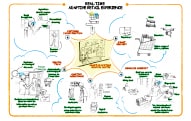AI/Automation
Adaptive Systems to Drive Hyper-Personalized Shopping Experiences
At the Consumer Electronics Show (CES) held in January 2018, participants witnessed some very impressive state-of-the-art retail solutions like in-store VR shopping, motion and traffic sensors, digital display signage and try-on room experiences. It was intriguing to watch robots’ welcome shoppers and initiate meaningful conversations. They even took up the role of sales associates, looking up product details and inventory. New technologies are poised to become part of the future brick and mortar stores and outlets as retailers shift towards providing experiences as a key differentiator
Retailers are looking beyond optimizing shopping transactions to providing experiences that the shopper can find engaging and exciting. Technology will play a key role in driving the in-store experience helping the brand and the retail outlet to develop a better relationship with the shopper. Recent studies have shown that shoppers are willing to pay more for a good shopping experience. These have prompted various retail brands ranging from existing players like Nike and Adidas to emerging players like Rebecca Minkoff and Farfetch, to open up experiential retail stores to capture and retain the customer’s mind space.
Digital makeover of the future brick & mortar stores
The Brick and Mortal stores of the future will be more of Concept stores or Experiential retail stores that would be characterized by:
- Brand awareness, with reduced focus on inventory and more focus on experience. These stores behave as brand awareness touchpoints rather than product distribution points
- Experiential kiosks, with increased mobility inside the store including mobile checkout kiosks and self-service counters
- Personalized recommendations which are data driven, where store associates would have real-time accessibility to customer information, shopping history, inventory levels etc.
- Robotic assistance like humanoids or chatbots or voice assistants to keep the shoppers engaged inside the store
- Smart Trial Rooms which can detect items taken inside the room, track what is being purchased or rejected as well as make recommendations
A walk through the Concept Store
A customer interacts with a Conversational Interface to research a lounger for her home and picks out a product from one of the home utility retail stores. She adds it to her online shopping cart, but decides to visit the store to see the lounger physically. Upon arrival, the retail store identifies the customer and pulls up the customer’s shopping cart.
The store associate is equipped with the relevant information on the hand-held device and is able to engage the customer in a meaningful conversation about the product. After viewing the lounger, the customer decides to make the purchase and is assisted by a humanoid which serves as a self-service kiosk.
The customer confirms the payment using facial biometrics and proceeds for checkout. The complete customer journey is seamless, driven by emerging technologies. This seemingly simple customer journey necessitates an IT system that can adapt itself to each customer’s needs on a real time basis at scale.
Adaptive systems for a seamless shopping experience
Various emerging technologies that include intelligent, self-adapting systems, come together to provide a unified shopping experience.
The retail stores of the future will utilize Machine Vision powered by on-premise cameras to identify customers and track their movements, enabling chatbots and humanoids to offer contextual assistance. In-store analytics will pick customer insights based on the dwell time across various sections in a store and the buying patterns to create a digital twin, viz., a virtual shopping profile that would contain the customer’s shopping history, preferences and more.
Location based services along with the digital twin will help stores create customized hyper-personalized recommendations. Inside the store, the shelves and trial rooms would have digital interfaces and sensors using AR/VR capabilities through which customers would be able to interact and engage with the brand.
The big bet is therefore on technologies such as, In-store Analytics, Machine vision driven customer tracking, Location based services, Conversational Interface, Cognitive Platforms and Blended Reality which together will interact to create a seamless shopping experience for the customer and help retailers build brand loyalty and maintain customer mindshare.
In order to achieve improved inter-system integration, better customer insights, efficient resource allocation and automated back-end operations, retail stores will have to implement IT systems which are adaptive in nature. Adaptive systems would open up numerous opportunities for system integrators in areas of application development and infrastructure services to name a few. Indeed, exciting times lie ahead for consumers and retailers with greater acceptance of the ‘new technology led experiences’ in the retail stores.





